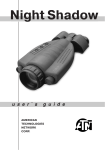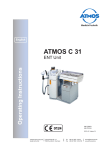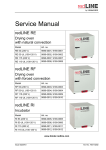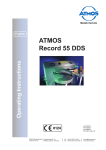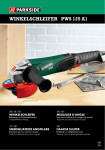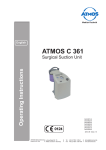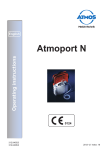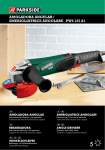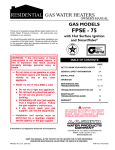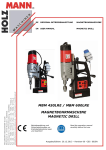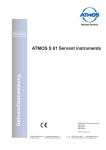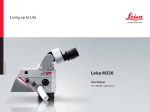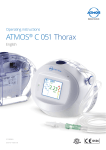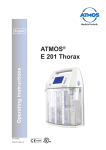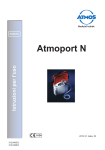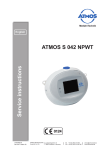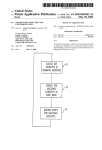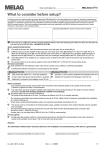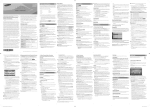Download 4.0 Operation
Transcript
English ATMOS S 41 Gyne Operating Instructions Gynaecological Workstation 601.0000.B 602.0000.B 603.0000.B 604.0000.B 2014-10 Index: 11 Contents Page page 1.0 1.1 1.2 1.3 1.4 2.0 Introduction Notes on operating instructions...........................3 Intended use........................................................4 Function...............................................................4 Explanation of symbols........................................5 3.0 3.1 3.2 Setting up and starting Front view............................................................8 Electrical connections..........................................9 For your safety............................................... 6-7 4.0 Operation 4.1 ATMOS S 41 Gyne - Basic unit.........................10 4.2 Basic functions..................................................10 4.2.1 Power supply.....................................................10 4.2.2 Maximum load...................................................10 4.3 Options.........................................................11-19 4.3.1 ATMOS RS 221 (RF surgery).......................11-12 4.3.2 ATMOS SE 6501Waste bin (optional)...............13 4.3.2.1 Operating elements...........................................13 4.3.2.2 Suction...............................................................13 4.3.3 ATMOS C 401 suction system...........................14 4.3.3.1 Operating elements 4.3.3.2 On/off switch......................................................14 4.3.3.3 Set vacuum.......................................................14 4.3.3.4 Close/open DDS collection jar handle...............15 4.3.3.5 Attach DDS collection jar handle......................15 4.3.3.6 Secure DDS collection jar handle......................15 4.3.3.7 Insert / remove DDS bacterial filter/ oversuction stop.................................................15 4.3.3.8 Using the DDS splash protector........................16 4.3.3.9 Attach DDS collection jar lid...............................16 4.3.3.10 Remove DDS collection jar lid...........................16 4.3.3.11 Insert/remove DDS hose adapter......................16 4.3.3.12 Connect hose....................................................16 4.3.3.13 Suction..............................................................17 4.3.3.14 Test DDS bacterial filter / oversuction stop........17 4.3.4 ATMOS Cam 31 TFT display (video system)....17 4.3.4.1 ATMOS Cam 31 DV..........................................18 4.3.4.2 Operating elements and front view....................18 4.3.4.3 Camera head.....................................................18 2 1.0 Introduction page 1.1 Notes on operating instructions...........................3 1.2 1.3 5.0 5.1 1.4 5.1.1 5.1.2 2.0 5.1.3 3.0 5.1.4 3.1 5.2 3.2 5.3 4.0 5.4 4.1 4.1.1 4.2 6.0 4.2.1 4.2.2 7.0 4.3 4.3.1 8.0 4.3.2 4.3.3 4.3.4 9.0 4.3.5 4.3.6 10.0 10.1 5.0 10.2 Intended use........................................................4 Cleaning care...................................... 20-21 Function..and .............................................................4 Instructions for cleaning and disinfection...........20 Explan of sympols...............................................5 Cleaning the surface of the unit.........................20 Cleaning "application components".............20 For yourthe safety ..................................................6 Secretion collection jar, bacterial filter and suction ..............................................20 Setting up hose. and .starting Instrument trays.................................................20 Front view............................................................7 Electrical connection. ...........................................8 Recommended instrument disinfectants............21 Recommended surface disinfectants.................21 Operation Cleaning and disinfection plan..................... 22-23 ATMOS S 41 Gyne - Basic device.......................9 Waste bin.............................................................9 Basic function......................................................9 Maintenance and service................................24 HMain switch.......................................................9 Maximum load.....................................................9 Trouble-shooting....................................... 25-26 Options..............................................................14 ATMOSoptions, RS 221 (RF-Surgery)...........................14 Further accessories ATMOS C 451 (Secretion suction device).........14 and consumables...................................... 27-29 ATMOS SE 6501 (smoke evaculation)..............14 Heates drawer...................................................14 Technical data..................................................30 ATMOS LS 21 LED (LED Light source).............14 ATMOS Cam 31 TFT-Display (Video system)...14 Checking / disposal. ........................................31 Checking ATMOS devices.................................31 Cleaning...........................................................15 Disposal.............................................................31 6.0 11.0 7.0 Maintenance Notes on EMC............................................ 32-34 and servicing...................................................17 8.0 Consumables, accessories and further options................................... 19- 22 9.0 Technical Data.................................................23 Trouble-shooting.............................................18 General Standard Terms and Conditions 10.0Disposal............................................................24 11.0 Notes on EMC...............................................25-27 1.0 Introduction 1.1 Notes on operating instructions These operating instructions contain important notes on how to operate the ATMOS S 41 Gyne safely, correctly and effectively. Their reading helps to avoid risks, and also to reduce repair costs and down-time. That increases, amongst other things, the reliability and service-life of the device. These operating instructions serve not only for new operating personnel to be instructed in its use, but also for use as a reference manual. Reproduction of these instructions – even in part – only with the written permission of ATMOS. These operating instructions must always be kept available near the device. Care and safety inspections in conjunction with professional execution provide for operational safety and readiness for use of your ATMOS S 41 Gyne and are therefore a must besides regular cleaning. Repair work and safety inspections may only be carried out by expert personnel authorised by ATMOS. By applying only original spare parts you will have the guarantee that operational safety, readiness for work and the value of your ATMOS S 41 Gyne will be preserved. ● The product ATMOS® S 41 Gyne bears CE marking according to the EC Directive of the council for medical products 93/42/EEC and meets the essential requirements of annex I of this directive. ● The product ATMOS® S 41 Gyne complies with all applicable requirements of the directive 2011/65/EC restricting the use of certain hazardous substances in electrical and electronic equipment (“RoHS”). ● The declaration of conformity can be obtained on our website at www.atmosmed.com. ● The quality management system applied at ATMOS has been certified according to international standards EN ISO 9001 and EN ISO 13485. ● Prior to start-up please peruse chapter 2.0 „For your safety“, in order to be prepared for any possible dangerous situations. These operating instructions are valid for the following devices ATMOS S 41 Gyne Single-tower module .......................REF 602.0000.0 Double-tower module ......................REF 601.0000.0 Three-tower module straight ...........REF 603.0000.0 Three-tower module angled ............REF 604.0000.0 Power supply 230 V.........................REF 601.1800.0 Power supply 100 V-127 V...............REF 601.1800.0 ATMOS MedizinTechnik GmbH & Co. KG Ludwig-Kegel-Str.16 79853 Lenzkirch Germany Power source ATMOS LS 21 LED ..REF 600.0003.0 ATMOS C 401 ................................REF 600.1500.0 Heated drawers Drawer type A 2 ..............................REF 601.2300.0 Drawer type type B 2 ......................REF 601.2700.0 Phone + 49 7653 689-0 Fax + 49 7653 689-190 + 49 7653 689-493 (Service Center) E-Mail: [email protected] Internet: www.atmosmed.de 3 1.0Introduction 1.2 Intended use Name: ATMOS® S 41 Gyne Main functions: Examinations and therapy in the gynaecological sector Med. indications/ application: For application on human bodies Specification of the main function:Positioning of instrumentation and accessories Illumination and visualization Extraction of substances and gas evacuation Surgical therapy by means of radio frequency Waste collection Application organ: Application time: Female body Temporary Application site: In gynaecologist clinics and practices Contraindications: Not to be used outside medical areas: Device must not be used in areas with a potential explosive hazard in rooms specified for medical treatment. The product is: X active not active Sterility:Not necessary Single use product / reprocessing: Indications for reprocessing are listed in the operating instructions 1.3Function The ATMOS S 41 Gyne is started up by connecting the plug to the power supply (fig. 4, page. 9). To determine the method of functioning of the standard units and the optional functions please consult pages 9 to 14, resp. consult the relevant user manual for the respective device: 4 ATMOS RS 221 (radiofrequency surgery) ATMOS C 401 (suction system) ATMOS Cam 31 (camera) ATMOS LS 21 LED (light source) 1.0 Introduction 1.4 Explanation of symbols On (for direct electric supply) according to IEC 417/5007 and DIN 30600/16 Short time rating Off (for direct electric supply) according to IEC 417/5007 and DIN 30600/16 Foot switch Pay attention to operating manual acc. to ISO /7000/0434 DIN 30600/1008 IEC 348 Fuse according IEC 417/5016, DIN 30600/0186 Heat emission general; heater for drawer Type B equipment acc. to IEC 417/5333 Application part acc. to type BF IEC 417/5333 ~ Alternating current Potential equalization ATMOS Cam 31, ATMOS Cam 31 DV IEEE 1394 Fuse according to IEC 417/5016, DIN 30600/0186 Freeze (Storing) Signal output Application part type BF Signal input Signal in and output DV-Connection Ground wire connection Foot switch ATMOS RS 221 Device classification: Type BF and defibrillator proof. Neutral electrode, grounded Device emits non-ionising radiation Neutral electrode (shines red by malfunetion) 0124 CE-mark in conformity with 93 / 42 EEC ATMOS SE 6501 Device classification: Type CF and defibrillator proof Device ON/ OFF ECB Used for communication to optional surgery device Abbreviations / symbols included in these operating instructions: Numeration Subdivision of a numeration/task. • The recommended order must be observed! Please read, important information ! Warning, special diligent notice! 5 2.0 For your Safety ! If several devices are connected via a joint mains supply then depending on the input of all the devices a medical insulating transformer acc. to EN 60601-1 with an insulating monitor or an equivalten safety system must be used. For your safety The control panel must be visible and easy to reach for the user. The ATMOS S 41 Gyne is: • designed in line with IEC 601 / EN 60601. • assigned to VDE safety class I • assigned to class IIa(EWG 93/42) of the German law on medical products. • assigned to class IIb by installation of ATMOS RS 221! Pay attention to the ambient conditions specified in chapter 9.0. The unit may only be connected to a protective terminal which has been installed in the prescribed manner. The ATMOS S 41 Gyne is separated from the electricity network via the rubber connector. Caution! The heated drawers could be subject to temperatures exceeding 40°C in certain circumstances! Check the temperature of the instruments prior to use. Contact service if need be! The ATMOS S 41 Gyne may only be used under the supervision of skilled staff who have been authorised by ATMOS and trained in its operation (IEC 601-1/EN 60601-1). Prior to first starting up, check whether the mains voltage specified on the type plate matches the local mains voltage. Prior to first starting up, check the functional reliability and overall condition of the device. Damaged cables and hoses must be replaced immediately! Display instruments and valves must be tested and in- spected at regular intervals to ensure correct functioning! Test and inspection of the vacuum display by the service technician during every safety-related test and inspection! Check proper assignment when assembling country- specific connections: green / yellow: non-fused earth conductor blue: neutral conductor black or brown: phase Please observe that the mobile parts could cause injury and contusion! If there is a failure in the temperature control then higher temperatures can occur. Prior to use check the tempe rature of the instrument. If necessary contact an ATMOS technician. 6 The suction system of the ATMOS S 41 Gyne is only designed for the extraction of irrigation fluids within the medical sector. The unit must not be employed for the extraction of explosive, inflammable, or caustic gases or fluids Switch off all function modules after daily practice. The ATMOS S 41 Gyne may be operated only in rooms used for medical purposes, but not in areas subject to explosion hazards and in oxygen rich environments. The ATMOS S 41 Gyne meets the immunity to interference requirements of IEC 601-1-2 / EN 60601-1-2 „Electromagnetic Compatibility – Medical Electrical Devices“. The ATMOS S 41 Gyne should not be operated with other devices, which do not correspond with the norm IEC 601-1-2 / EN 60601-1-2 "medical electrical devices and electromagnetic compatibility (medical elec trical devices). No warranty rights shall exist in the event of damage or failure caused by the use of non-ATMOS accessories or non- ATMOS consumables. ATMOS will not be liable for damage to people or property if: • any non-original ATMOS parts are used. • the instructions for use contained in these operating instructions have been disregarded. • assembly, resetting, alterations, extensions and repairs have not been carried out by people authorised by ATMOS. The operating instructions correspond to the design of the unit and are based on the status of the prescribed industrial standards dealing with safety at the time of publication and printing. All listed circuits, processes, names, software programmes and devices are protected by copyright. Please pay attention to the safety notes contained in the following chapters The design of the ATMOS C 401 fulfi lls the requirements of IEC 601/EN 60601 and of protection class I. The device must only be connected to a properly installed socket with non-fused earthed wire. 2.0 For your Safety ! For your safety Before putting the device into operation, visually check unit,collection jar, power cable, accessories, connection cables and hoses for signs of damage. Damaged cables and hoses must be replaced immediately. Check also function of the unit. Liquids must not be allowed to enter the device. Should liquids have penetrated into the device, it must be inspected by an authorized service technician before being used again. Danger of tipping over! If you are transporting a straight (not angled) workstation with two or three modules (REF 601.0000.0 / REF 603.0000.0), prior to transport the drawers must be secured to prevent them from slipping out. After transport at cold temperatures (below the freezing point), the unit must acclimatize prior to first use; leave it unoperated at room temperature for a period of up to 6 hours. If the unit is not acclimatized it must not be operated as the membranes of the pump might get damaged. The suction hose must never come into direct contact to the application area. A suction catheter, attachment or a medical aspiration set must always be connected to the hose. When disconnecting the device from the power line, first remove the plug from the wall outlet. Then the power cord may be disconnected from the device. Never touch the plug or cord while your hands are wet. This product is not re-sterilisable. Repeated reuse of components which are marked with a 2 is forbidden. In case of repeated reuse these components lose their function and there is a high infection risk. Notes on EMC The ATMOS S 41 Gyne is an examination and treatment unit designed for use in the gynaecological sector, combining several single medical products in one system according to your individual configuration.Each installed device has been typetested for EMC. Following the review of all individual test reports, we can declare that a significant deterioration in the stray radiation value due to the combination of the devices in the unit is not to be expected, and what is more, deterioration in the interference immunity can safely be excluded. Please observe the instructions relating to EMC in the relevant unit-specific user manual which is enclosed with your supplied unit. 7 3.0 3.1 Setting up and starting Front view 12 10 11 13 14 Fig 1. ATMOS S 41 Gyne Front view Swivel-mounted instrument trays (optional) ATMOS Cam 21 / 31 module (optional) ATMOS RS 221 radiosugery device (optional) ATMOS SE 6501 smoke evacuation system (optional) ATMOS C 401 (optional) Drawers, heated and unheated (optional) Instrument deposit PC support Glove dispenser (optional) Instrument deposit with cover (optional) 11 Drawer for electrodes (optional) TFT display (optional) 13 Swivel arm with deposit (optional) 14 Connection for foot switch Castors for mobility (optional) (no illustration available) 12 8 3.0 3.2 Setting up and starting Electric connections The power cable of the ATMOS S 41 Gyne should be connected to a shock-proof plug terminal in the immediate vicinity of the unit (max. 3 m). The current consumption of ATMOS S 41 Gyne is maximum 7 A. Please provide an adequate number of shock-proof plug terminals to supply the additional electrically operated units which are not defined as options, at the workstation of the gynaecologist. Multiple sockets with moveable connection cable may not be used (please see safety notes)! 9 4.0 Operation 4.1 ATMOS S 41 Gyne - Basic unit The unique concept of the workstation from ATMOS centralises and integrates all the devices required for diagnosis and treatments and improves your workflow. Based on your findings any outpatient treatments can be performed directly and without any long waiting time in one room. The instrument storage area: A storage area for medicine bottles and consumables (), is located at the head of the function column allowing you to use this storage area for the deposit of instruments in an optimal manner. You also have the opportunity to store instruments and accessories, which are rarely required, in the drawers () to facilitate protection of these implements. Most surface areas of the unit are coated with a special structural varnish which complies with the hygienic demands of the workplace. However, any drops, which have been spilt, should be removed immediately from the unit as the varnish is not resistant to all medical products and disinfectant solutions. Fig 2. 4.2 Basic functions 4.2.1 Power supply (optional) The ATMOS S 41 Gyne is disconnected from the power + Fig 3. supply by pulling out the inlet connector for unheated apparatus. 4.2.2 Maximum load Do not lean against the ATMOS S 41 Gyne unit (danger of unit tilting). Maximum load of the function carrier: 12 kg. 10 4.0Operation 4.3Options 4.3.1 ATMOS RS 221 (REF 601.1700.0) Please pay attention to the safety and operating notes in the attached operating manual. Fig 4. ATMOS RS 221 ON I OFF 0 Symbol for operating mode neutral electrode Symbol for neutral electrode (glows red at malfunction) Symbol for type of device according to EN 60601 MONO CUT Cutting monopolar Monopolar cutting with coagulation / setting of coagulation degree Output / coagulation degree lower Output / coagulation degree higher Display output / coagulation degree Fig 5. MONO COAG Permanent coagulation monopolar / setting of coagulation degree Pulse coagulation monopolar / setting of pulse duration Output / coagulation degree / pulse duration lower Output / coagulation degree / pulse duration higher Display output / coagulation degree / pulse duration BIPOL COAG Permanent coagulation bipolar / setting of coagulation degree Pulse coagulation bipolar / setting of pulse duration Output / coagulation degree / pulse duration lower Output / coagulation degree / pulse duration higher Display output / coagulation degree / pulse duration 11 4.0Operation Fig 6. Connection neutral electrode Connection monopolar COAG Connection monopolar cut Connection bipolar COAG Gynecology Recommended adjustment Recommended type of electrodes Conisation on the portio uteri ca. 65 ca. 40 BIO-CONE loop electrode Gynaecomasty ca. 27 CUT blade electrode Multi-Tip test excision (vulva) ca. 22 CUT Rhomb electrode mamma reduction (see also subcutaneous fat tissue) ca. 28-30 CUT; CUT/COAG Needle electrode, Multi-Tip Mamma augmentation see also subcutaneous fat tissue) ca. 28-30 CUT; CUT/COAG Needle-, blade electrode 12 CUT/COAG c3 CUT/COAG c3/c2 4.0Operation Setting operation suction Operation suction is the suction capacity during activation of the electrosurgical unit or after manually starting the ATMOS SE 6501. The terms manual start and manual deactivation mean the use of the <Start suction> button. Select a value between 20% and 100%. 100% corresponds to a suction capacity of approx. 650 l/min. Fig 7. 4.3.2 Setting the down time The operation suction runs on for a specified length of time after the ATMOS SE 6501 is deactivated. This period of time is the run-on time ( Fig. 8). Select a value between 0 and 10 seconds. SE 6501 ATMOS SE 6501 (REF 601.1900.0) You can also let the operation suction continue running for an indefinite period after deactivation of the electrosurgical unit or after manual deactivation of the ATMOS SE 6501 (Fig. 8). Select a period longer than 10 seconds, using the <Higher> / <Lower> buttons. The word "On" appears on the display. This means that the permanent operation suction mode is activated. The permanent Operation suction can be switched on and off with the <Start suction> ( Fig. 8) button. Please pay attention to the safety and operating notes of the attached operating manual. Whenever the electro-surgical device is used, the smoke evacuation device automatically switches to extraction operation, returning to basic suction operation after completion of the incision procedure and the tracking sequence. 4.3.2.3 Suction ! Position the suction device, or the instrument with suction device so that it cannot accidentally suck up swabs or the like. Press the Start suction button. The unit operates for as long as the button is pressed or activate the attached laser or electro surgical device. Suction then continues for the duration of the set run-down time, after which basic suction takes place for the duration of the set basic suction time. Fig 8. 4.3.2.1 Operating elements WARNING! ! WARNING! Mains switch Mains filter Value higher / value lower Never bring the suction tube into contact with the suction site. It could become fixed to the tissue. Indication of suction capacity Do not suck up any liquids. If there is a risk that you could suck up liquids during the operation, attach an in-line filter on the main filter. Replace the in-line filter immediately if you have sucked up any liquid. Button to adjust the value in the display. 4.3.2.2 Switching on the ATMOS SE 6501 Switch on the power switch ( Fig. 8). The ATMOS SE 6501 performs a self-test. All the displays illuminate. ATTENTION: For smoke evacuation we recommend the use of the ATMOS specula. Suction, performance and run-down time are adjustable. Select the desired function ( Fig. 8). Using the valie higher / lower buttons you can change the value of the selected function. The figure that you see on the display is either a percentage or seconds. The percentage symbol or seconds symbol illuminates. The percentage figure refers to the unit's maximum output (650 l / min). 13 4.0Operation 4.3.3 ATMOS C 401 (REF 604.1500.0) Suction system with DDS-System (Direct Docking System) Please pay attention to the safety and operating notes in the attached operating manual. 4.3.3.1 Operating elements Fig 9. On/off switch with control display Vacuum gauge Vacuum control ATMOS C 401 4.3.3.2 On/off switch Press the ”I” symbol to switch the unit on. Press the ”0” symbol to switch the unit off. 4.3.3.3 Set vacuum Close the suction hose and set the desired vacuum by turning the vacuum controller according to the direction of the arrow. Fig 10. + 14 Do not use force to turn the knob to its limits! Test the system for leaks if the desired vacuum is not achieved. 4.0Operation 4.3.3.4 Close/open DDS collection jar handle To close, secure the snap-in hooks under the edge of the collection jar, and then press the clips downwards until they lock into place (see FIg. 11). To open, pull the clips upwards to release the snap-in hooks and remove from under the edge of the collection jar. Fig. 11. Fig. 12. 4.3.3.5 Attach DDS collection jar handle Fix the container handle into the guiding of the lid with opened snap-in hook . Fix the snap-in hook below the container edge and press the lever towards the centre of the container until the handle snaps in. Use of the second container. Move the lever in the direction of the container which is not in use. 4.3.3.6 Secure DDS collection jar For removal, lift the DDS collection jar vertically upwards; to insert it again, allow it to slide vertically downwards into the securing device (see Fig 13). Fig. 13. 4.3.3.7 Insert / remove DDS bacterial filter/ oversuction stop Use gloves! The DDS bacterial filter is inserted into the DDS collection jar handle. Fig. 14. To do this separate the DDS collection jar handle and DDS collection jar lid. Plug the DDS bacterial filter onto the cross in the middle of the DDS collection jar handle (see image 14) put the DDS collection jar handle onto the DDS collection jar lid. 15 4.0Operation 4.3.3.8 Using the DDS splash protector Insert the DDS splash protector into the inner part of the collection jar lid (see Fig. 12). Fig. 15. 4.3.3.9 Attach DDS collection jar lid With the DDS collection jar on a firm surface, position the lid horizontally on top (the lid may not be twisted!) (see Fig. 16). Press down lightly onto the collection jar using both hands until the limit is reached. Fig. 16. 4.3.3.10 Remove DDS collection jar lid Lift the complete container upwards with one hand at the container handle. With the other hand the base of the container is guided in order to prevent the container from tilting when lifting it. Press the lever apart (see Fig. 18). Unhinge the snap-in hook of the container handle at the container. Pull out the snap-in hook with both hands and remove the container handle upwards. Remove bacterial filter/oversuction stop from the container handle. Remove the container lid from the container with both hands. Remove the splash protection. Fig. 17. 4.3.3.11 Insert / remove DDS hose adapter Press the required DDS hose adapter with 6 or 10 mm diameter into the ”Patient” hole of the DDS collection jar lid twisting slightly to ensure a tight fit (see Fig. 18). Twist slightly in the same manner when removing. Fig. 18. 4.3.3.12 Connect hose Fix the hose tightly to the adapter (olive) (see Fig. 19). Fig. 19. 16 4.0 Operation 4.3.3.13 Suction Use appropriate suction catheters, suction tips or suction instruments. Make sure to disinfect the suction hose, the suction instruments and the complete secretion canisters prior to every application on a patient. Keep an eye on the level of liquid in the collection container during suction The hydrophobic bacterial filter safely prevents liquid from getting into the pump. Nevertheless, the collection container should be replaced when 2/3 full. 4.3.3.14 Test DDS bacterial filter / oversuction stop The DDS bacterial filter / oversuction stop is disposable. Before each use, check that the DDS bacteria filter / oversuction stop is clean and dry. Wet or dirty filters must be replaced with new ones. The filter is no longer in optimum condition if the vacuum displayed is above -0.3 bar when the vacuum controller is in the ”max.” position and the suction hose is open. The filter must then be replaced. Replace the DDS bacterial filter at least once a day. Use only original ATMOS bacterial filters! Never operate the unit without the DDS bacterial filter / oversuction stop! 4.3.4 Video system (ATMOS Cam 31 DV, TFT display) (601.1600.0 and 534.3015.0, 534.3010.0) To allow the patient to follow and visualise the findings of the endoscopic resp. colposcopic procedures, the ATMOS S 41 Gyne can be supplemented optionally by a video sy-stem, consisting of a camera as well as a display on the arm carrier. A suspending of the video image can be obtained by means of activation of the foot lever (camera accessory). Please observe the safety and the operating instructions contained in the enclosed user manual. Fig 20. TFT display and ATMOS Cam 31 DV Additional devices (video printer, video recorder, computer etc.) to be used for the transmission of video signals must be licensed as medical products 17 4.0 Operation 4.3.4.1 ATMOS Cam 31 DV ! Please note: Read these separate operating instructions attentively and follow the stated notes for your safety to guarantee ideal and safe use of all functions! 4.3.4.2 Controls and front view Buttons for selecting application part and light source A Connection for camera head for LED B Connection light source Mains on/off switch 4.3.4.3 Camera head 1 2 click Choose light source 1) At the treatment unit: Take out the requested light source. The adjustments (LED, Halogen) have been set ex works. 2) Directly at the camera: Take out the requested light source (see above). Choose the desired optics by pressing the button at the camera (). Choose the in use light source (). When using the camera next time, all adjustments will be taken over from prior use. 1 Fig 21. 18 2 4.0 Operation 4.3.5 ATMOS LS 21 LED light source (600.0011.0) Please pay attention to the safety and operating notes of the attached operating manual. Fig 22. ATMOS LS 21 LED click 4.3.6 Heated drawer Please check the temperature of the instruments prior to application. In case the temperature control is defective, temperatures exceeding 40°C could occur. If need be, please contact service! ! Type A 2 Type B 2 (601.2300.0) (601.2700.0) Maximum load: 10 kg Mains switch is accessible after pulling out the drawer. Fig 23. Heated drawer 4.3.7 Instrument wet storage (optional) Comprises of a removable disinfectant resistant stainless steel container with sieve. Dimensions: 374 mm x 289 mm x 233 mm Reservoir capacity: 20 litres 4.3.8 Disposal collection The door of the disposal collection unit is equipped with a „kick-box“-locking mechanism. By tapping on the door with your hand or foot, you will open the locking mechanism and the disposal collection bin will be opened automatically. Fig 24. When you close the door, "the kick-box" locking mechanism locks automatically." ! Caution with contact or exposure to contaminated waste! Danger of infections! 19 5.0 Cleaning and care 5.1 Instructions for cleaning and care Set main switch to OFF prior to cleaning and disinfection! The described action relating to cleaning and disinfection resp. disinfection do not substitute the relevant instructions which must be adhered to prior to operation! 5.1.3 At the end of every working day all following components must be cleaned and disinfected: Secretion collection jar equipped with locking system and bacterial filter: • Gently disconnect all hose couplings on the locking systems and carefully remove the collection jar, ensuring that the environment is not contaminated by splashes of waste product. • Dispose of waste in the prescribed manner. Hold the locking mechanism firmly, open the filter housing by turning in an anti-clockwise direction and then remove the filter. Rinse all parts thoroughly under running water. • Disinfection with disinfectants recommended in chapter 5.3 for surface disinfection A detergent or cleaning agent can also be employed. • Insert the filter after cleaning (smooth side downwards!). For disinfection, you may use all surface and instrument disinfectants listed on page 21. Always observe the concentration specifications and instructions by the respective manufacturer ! Do not use • • Disinfectants containing concentrated organic or anorganic acids or bases, since these may cause corrosion damages; Disinfectants containing chloramides, phenol derivatives or anionic tensides, since these may cause stress cracks in the material used for the housing of the unit. Secretion collection jar, bacterial filter and suction hose Suction system and hose connection: • 5.1.1 Cleaning the surface of the unit The surfaces of the ATMOS S 41 Gyne are resistant against all surface disinfectants listed on page 21. Always rinse the suction system carefully after use, by sucking in a little detergent (e.g. ATMOS Special Cleaner 080.0005.0). This procedure will prevent adhesion and congestion within the suction hoses over the period of utilisation. • Immersing the hose into disinfection solution. Rub the surface area of the unit with a cloth which has been moistened with cleaning agent or disinfecting solution. Disinfecting sprays or cloths impregnated with disinfec- tant can also be used for the cleaning and disinfection process. Please note that the alcohol contained in these agents could corrode or cloud the protective covers if employed on a long term basis. Change the filter! ! Caution with contact or exposure to contaminated waste! Danger of infection! 5.1.4 Instrument trays Prior to disinfection rinse trays thoroughly under running 5.1.2 Cleaning the „application components“ "Application parts“ comprise of: All separate parts or assemblies which come into direct contact with the patient and could therefore be subject to contamination: • collection container • secretion hose, • nozzles of medicament sprayers, • Politzer olives and adapters. All application components can be • disinfected using the recommended instrument disinfecting solution (see page 21). All application components, which come into direct contact with the patient during treatment must be exchanged immediately for hygienic reasons and disinfected. 20 water. You can also use a dish liquid (detergens) or cleaner. • Residue from these agents must be removed thoroughly. • Disinfection of the tray with disinfectants recommended in chapter 5.3 for surface disinfection Stainless steel trays and trays made of anodized aluminium can be cleaned automatically (Neodisher MediClean forte). They can also be disinfected thermally at a temperature of 93°C. Trays made of melamine do not resist temperatures of 93°C. 5.0 Cleaning and care 5.2Recommended instrument disinfectants The ATMOS S 41 Gyne instruments can be cleaned with disinfectants with the following active ingredients: • • • • amines ammoniumchloride compounds aldehydes phosphates 5.3Recommended surface disinfectants The ATMOS S 41 Gyne surfaces can be cleaned with disinfectants with the following active ingredients: • ATMOS recommends: Green & Clean SK quaternary ammoniumchlorides If using aldehyde-containing or amine-containing disinfectants at the same object, this may result in discolourations. 21 5.0 Cleaning and care and disinfection plan Cleaning ATMOS S 41 Gyne MedizinTechnik Cleaning and disinfection plan D S Recommendations Disinfection Sterilisation Who Monthly C Cleaning When Weekly Reusable parts How Daily What After each procedure 5.4 w Secretion canister Secretion suction hose Monthly exchange. X X X2), 4), 5) Cleaning and disinfection (manually or automatically) X Hose connection (nozzle) X X2), 4), 5) Cleaning and disinfection (manually or automatically) X Suction lid X X2), 4), 5) Cleaning and disinfection (manually or automatically) X Hand grip X X2), 4), 5) Cleaning and disinfection (manually or automatically) X Gasket X X 2), 4), 5) Bacterial filter Secretion collection canister X X2), 4), 5) Cleaning and disinfection (manually or automatically) X Daily exchange or when filter is blocked X Empty when canister is full. X Cleaning and disinfection (manually or automatically) Instrument management Gynaecology instruments X X Canister X X4) Sieve X X2), 4), 5) Splash protection X X Immerse instruments into solution immediately after use, complete wetting is required, air must be removed from any cavities, after the contact time instruments must be cleaned with a brush and rinsed with water, have to be dried and sterilised after-wards. Please also observe the ATMOS operating instructions for GYNE instruments. X X Wet storage Manual cleaning and disinfection. X Cleaning and disinfection (manually or automatically) X X Manual cleaning and disinfection. X X3) Wipe cleaning and wipe disinfection. X Immediate pre-cleaning after each procedure (wipe disinfection) Reprocessing acc. to instructions stated in the operating instructions. X 4) Visualisation ATMOS Cam 21 / 31 Rigid scope X X1) Light conductor X X3) Wipe cleaning and wipe disinfection. X Light source X 3) X Wipe cleaning and wipe disinfection. X Microscope / Colposcope X X3) Wipe cleaning and wipe disinfection. X X1) Radiofrequency surgery ATMOS RS 221 (surface) X X Ergonomic plastic handles X X2), 4), 5) X1) Wipe cleaning and wipe disinfection. X Bipolar-tweezers X X2), 4), 5) X1) X X2), 4), 5) X1) Immediate pre-cleaning after the procedure or dispose of in wet disposal tray; use of enzymatic detergents X Bipolar electrode Bipolar electrode cable X X X X Neutral electrode X X2), 4), 5) X1) Neutral electrode cable X X X1) GYNE electrodes X X X(1,6) Immediate pre-cleaning after the procedure or dispose of in wet disposal tray; use of enzymatic detergents Immediate pre-cleaning after the procedure or dispose of in wet disposal tray; use of enzymatic detergents Immediate pre-cleaning after the procedure or dispose of in wet disposal tray; use of enzymatic detergents Wipe cleaning and wipe disinfection. 1) X X X X X Smoke evacuation Suction hose Surface filter housing 2012-04 Index: 02 22 X X X2), 4), 5) X Cleaning and wipe disinfection (manually or automatically) X monthly exchange Wipe cleaning and wipe disinfection X X Qualified and trained staff who are familiar with reprocessing. (Please fill in the responsible person -> use a water-based overhead marker) 5.0 Cleaning and care S Disinfection Sterilisation Who Monthly D Recommendations Weekly C Cleaning When Daily Reusable parts How After each procedure What Qualified and trained staff who are familiar with reprocessing. (Please fill in the responsible person -> use a water-based overhead marker) Surfaces Housing X X3) Wipe cleaning and wipe disinfection. X Shutter X X3) Wipe cleaning and wipe disinfection. X Rotary arm X 3) X Wipe cleaning and wipe disinfection. X Drawers X X3) Wipe cleaning and wipe disinfection. X Ablagefläche X X3) Wipe cleaning and wipe disinfection. X Halter Handschuhspender X 3) X Wipe cleaning and wipe disinfection. X PC-Halterung X X3) Wipe cleaning and wipe disinfection. X Rollen X X3) Wipe cleaning and wipe disinfection. X Waste disposal X X Instrument tray Melamin X X3) Recommended disinfectants 3) Surface disinfection for coated surfaces: Green & Clean SK (ATMOS) Dismozon® pur (Bode Chemie) Kohrsolin® FF (Bode Chemie) Perform® (Schülke & Mayr) Terralin® Protect (Schülke & Mayr) Other surfaces: 4) Instruments - manual disinfection: Korsolex® AF (Bode Chemie) Korsolex® basic (Bode Chemie) Korsolex® plus (Bode Chemie) Korsolex® extra (Bode Chemie) neodisher® Septo MED (Dr. Weigert) neodisher® Septo 3000 (Dr. Weigert) Sekusept® aktiv (Ecolab) Gigasept® Instru AF (Schülke & Mayr) Gigazyme® (Schülke & Mayr) Gigasept FF neu (Schülke & Mayr) 5) Wipe cleaning and wipe disinfection., every day or when emptying the container. Wischreinigung und -desinfektion, every day or when replacing with new instruments 3) Dismozon® pur (Bode Chemie) Kohrsolin® FF (Bode Chemie) Bacillocid® rasant (Bode Chemie) Mikrobac® forte (Bode Chemie) Perform® (Schülke & Mayr) Terralin® Protect (Schülke & Mayr) Surface disinfection FD 312 (Dürr Dental) Quick disinfection B 30 (Orochemie) Please see the manufacturer‘s instructions for concentration, contact time, temperature and the compatibility of materials. X Important information Wipe cleaning and wipe disinfection: All surfaces have to be wiped with a clean (disposable) wipe which is damped with disinfectant solution; the entire surface has to be wiped thoroughly and may not be dried afterwards. 1) Please observe the manufacturer‘s operating instructions. 2) Alternative to automatic cleaning and disinfection: cleaning and disinfection device 78°C Instruments - automatic disinfection: Dismoclean® 21 clean (Bode Chemie) Dismoclean® 24 Vario (Bode Chemie) Dismoclean® 28 alka one (Bode Chemie) Dismoclean® twin basic/twin zyme (Bode Chemie) neodisher® FA (Dr. Weigert) neodisher® FA forte (Dr. Weigert) neodisher® MediClean forte (Dr. Weigert) Thermosept® alka clean forte (Schülke & Mayr) Thermosept® RKN-zym (Schülke & Mayr) X Wrong concentration of disinfectants may lead to damage! The above stated hygiene requirements are based on the regulations according to the Medical Devices Act, the Medical Devices Operator Ordinance, §18 IfSG and the recommendations of the Robert Koch Institute. Definition of the required reprocessing steps result from the recommendations of the Robert Koch Institute: „Requirements for the reprocessing of medical products“. The medical products were categorised in the risk groups uncritical, semicritical and critical. The reprocessing steps stated in this diagram have to be performed. Any additional reprocessing measures are at the operator‘s discretion. All the recommended disinfectants which are stated herein are listed disinfectants (VAH/RKI) and have been tested on their suitability of use on the ATMOS S 41 Gyne. ATMOS MedizinTechnik cannot be hold liable for any damage caused by wrong concentration of the disinfectants or by the application of any other disinfectants. Patients with suspicion of a clinical disease or who developed a transmissible spongiform encephalopathy (CJK, vCJK, etc.) have to be treated at facilities which are able to provide for the necessary preventive measures against infection. The reprocessing of the reusable instruments and material may only be performed at facilities which have an externally certified QM Management acc. to DIN EN ISO 13485/13488. The Medical Devices Act, IfSG, the RKI directives, BGR 250 and TRBA 250 always have to be considered. ATMOS MedizinTechnik GmbH & Co. KG Ludwig-Kegel-Str. 12,14-16,18 79853 Lenzkirch/Germany Phone +49 7653 689-0 Fax +49 7653 689-190 [email protected] www.atmosmed.de 23 6.0 Maintenance and service The ATMOS S 41 Gyne is equipped with a maintenance free aggregate for the extraction process. Nevertheless, some simple maintenance work, which can be carried out by the operator, will still be required to ensure that the unit will continue to function correctly for a long period of time; however, this procedure can also be carried out by our service team if desired. An annual safety test and inspection must be conducted on the ATMOS S 41 Gyne unit according to the guidelinesfor the prevention of accidents. We also recommend an annual maintenance check according to the ATMOS S 41 Gyne instructions of service. The electrical options "special electrical surgical units" are subject to the relevant operating manuals and the specified inspection, testing and maintenance instructions stated therein. 24 7.0 Trouble-shooting 7.1 Electrical protection The power voltage is supplied to the individual modules via an inlet connection for non-heating apparatus. The power supply is guaranteed by means of fusible cut outs in the inlet connection on the rear side of the unit. Fig. 25. Note: Please observe the possible causes of malfunction, and the recommended action to alleviate disturbance contained in the user manual relating to the units which are supplied as options. Please check your system according to the following diagrams before you get in touch with the ATMOS Customer Service: 7.2 Power supply Faults in the unit No voltage to the unit – function control lamps not activated – No voltage at the power plug • Check the fuse, check the terminal – Blown fuse • – Power plug resp. cable defective • • 7.3 • Heated drawer using other devices (lamps) if necessary Exchange the fuses at the rear of the unit Check the power plug resp. cable, and exchange if necessary Check the fuses of the individual units Get in touch with ATMOS-Service Faults in the unit No heating, control lamp activated Control electronics or heater is defective Get in touch with the Service No heating, control lamp not activated Blown fuse, power plug / cable defectivet Check the fuses Remove the drawer completely and check the cable resp. plug connection. 25 7.0Trouble-shooting 7.4 Suction system Fault in the unit Poor or no extraction – Suction hose is congested • Check the auxiliary air control – auxiliary air control open! • Rinse the suction hose with water – Cover of collection jar is not properly fitted – bacterial filter is congested – Suction coupling is leaking – Hose coupling bent or snapped – Secretion in suction pump No suction although vacuummeter shows -0,7 bar – Suction hose is congested • Rinse the suction hose with water – Connection hose bent or snapped (you can remove the hose for this purpose) • Check the level of fluid in the secretion collection jar • Exchange the bacterial filter • Check the hose couplings, eliminate any kinks – Pump / motor defective • Please contact your service technician – Bacterial filter is congested No extraction and suction motor does not start, control lamp activated (the hose can be removed for this purpose • Check the level of fluid in the secretion collection jar • Check the seating of the cover of the secretion collection jar. • Change the bacterial filter • Seal the connection or replace if necessary • Check the hose couplings, eliminate kinks • Have the pump cleaned by the service technician recommended and authorised by ATMOS + Please get in touch with the service technician immediately if the fault cannot be alleviated with the aid of these diagrams. Do not attempt to carry out any repair action yourself! + See also the relevant chapter contained in the separate user manual! 26 8.0 Consumables, accessories and further options Power supply REF Option for electrical installation 230 V 601.1800.0 Option for electrical installation 100 V - 127 V 601.1800.4 Drawers REF Drawer type A1 601.2000.0 Drawer type A2 601.2300.0 Drawer type A3 601.2200.0 Drawer type A4 601.3200.0 Drawer type B1 601.2400.0 Drawer type B2 601.2700.0 Drawer type B3 601.2600.0 Drawer type B4 601.3300.0 Drawer type C1 601.2800.0 Instrument wet storage 601.3100.0 Waste bin 601.3000.0 Additional options REF Function support on swivel arm for double- and three-tower workstation including accessories 601.1400.0 Function support on swivel arm for single-tower workstation including accessories on request Fixation bar for optional fixation of function support, swivel unit 601.1300.0 Monitor support 601.4100.0 Laptop support with a short swivel arm 601.3700.0 Swivel support with two small instrument trays 601.3600.0 Swivel support with one big instrument tray 601.3500.0 Accessories REF Dispenser for disposable gloves 601.4200.0 PC support 601.4000.0 Visual cover for DDS secretion canister 601.3900.0 Stainless steel container on request Instrument deposit 601.3800.0 ATMOS S 41 Gyne – Options for visualisation REF ATMOS Cam 31 DV 601.1600.0 Power source for ATMOS LS 21 LED 600.0003.0 ATMOS LS 21 LED light source 600.0011.0 TFT monitor professional 534.3015.0 TFT monitor basic 534.3010.0 27 8.0 Consumables, accessories and further options Options for radiosurgery REF ATMOS RS 221 - radiosurgery - installation module 601.1700.0 Monopolar accessories set gynaecology 600.0159.0 ATMOS SE 6501 - smoke evacuation system - installation modul 601.1900.0 Secretion suction REF ATMOS C 401 - suction module 601.1500.0 Accessories radiosurgery REF Monopolar accessories set gynaecology 600.0159.0 Bipolar set 506.5860.0 Handpiece for conisation 600.0161.0 Foot switch ATMOS RS 221 506.5861.0 Conisation electrode Bio-Cone 9 x 30 mm 600.0162.0 Conisation electrode Bio-Cone 15 x 18 mm 600.0163.0 Conisation electrode Bio-Cone15 x 24 mm 600.0164.0 Conisation electrode Bio-Cone 18 x 24 mm 600.0165.0 Conisation electrode Bio-Cone15 x 30 mm 600.0166.0 Handle for loop electrode 600.0171.0 Loop electrode, D = 10 mm 600.0167.0 Loop electrode, D = 15 mm 600.0168.0 Loop electrode, D = 20 mm 600.0169.0 Loop electrode, D = 25 mm 600.0170.0 Ball-shaped electrode, D = 2.3 mm 600.0472.0 Magnetic support for handles on request Accessories ATMOS C 401 REF Hose with rotary connection 401.0553.0 Suction curette, with auxiliary air vent, external-Ø 6 mm 401.0529.0 Suction curette, with auxiliary air vent, external-Ø 8 mm 401.0530.0 Suction curette, with auxiliary air vent, external-Ø 10 mm 401.0531.0 Suction curette, with auxiliary air vent, external-Ø 12 mm 401.0532.0 Suction curette, with auxiliary air vent, external-Ø 14 mm 401.0533.0 Suction curette, for sample taking, Ø 3 mm 401.0554.0 Suction curette, for sample taking, Ø 4,5 mm 401.0528.0 28 8.0 Consumables, accessories and further options Consumables ATMOS C 401 REF DDS bacterial filter 340.0054.0 Tissue collector 340.0061.0 Collecting sieve for tissue samples 401.0555.0 DDS adapter for tissue collector 340.0062.0 Adapter tissue collector for Receptal 444.0148.0 Suction hose, D = 6 mm, L = 2 m 000.0361.0 Suction hose, D = 6 mm, L = 2.1 m, not autoclavable, 50 pcs. 006.0059.0 Consumables ATMOS SE 6501 REF Main filter unit, ULPA, change after 150 patients 445.0040.0 Pre-filter (HEPA), increases filter lifetime, use is manadatory in combination with laser applications, 50 pcs., sterile, single-use 445.0044.0 Air hose, internal diam. 10 mm, L = 1.8 m 005.0204.0 Connection hose, straight, D = 22 mm (M) to D = 10 mm (M) 006.0689.0 Connection hose, straight, D 22 mm (W) to D 10 mm (M) 006.0688.0 ATMOS Chair 41 Gyne Examination Chair REF ATMOS Chair 41 Gyne 503.0550.0 Leg holders „Goepel“ 503.0551.0 Leg support, 1 pair 503.0554.0 Leg rest extendable 503.0552.0 Colposcope holder, Zeiss and Kaps 503.0553.0 Stainless steel secretion basin 503.0581.0 Doctors chair 503.0570.0 29 9.0 Technical data Power Voltage Max. one drawer with instrument heating is obtainable for 230 V ± 10 %, 50/60 Hz, at 230 V and 60 Hz and equipment with all function modules! Special Voltage 115 V~ and Special Voltage 127 V~ Current input Cam 31 / Cam 31 DV Monitor LS 21 LED C 451 RS 221 SE 6501 Heated drawer Total current fully equipped 0.15 A (35 VA) 1.0 A (220 VA) 0.04 A (10 VA) 0.45 A (100 VA) 0.95 A (220 VA) 1.4 A (330 VA) max. 1.0 A (max. 230 VA) 7 A (1600 VA) 230 V~ Power consumption fully equipped max. 1600 VA Current Supply Detachable power line with shock-proof plug, line cord 5 m ATMOS Cam 31 module 1/3” CCD, 752 x 582 pixels, digital zoom x2, 1 – 4 image storage, PAL TFT monitor 15“ 1024 x 768 (max. 1600 x 1200) Light source ATMOS LS 21 LED Max. 10 VA Power input; Output 1: 700 mA for LED, Output 2: 2.4 V; 0.5 A for nystagmus bioculars Suction system ATMOS C 401 40 l/min ± 10 % (freeflow); Vacuum: 90 % of ambient pressure; secretion container 1 x 1.5 l and 1 x 3.0 l Radiosurgery device ATMOS RS 221 module 2.2 MHz cutting (100 W) and coagulating (90 W), mono- and bipolar Smoke evacuation module ATMOS SE 6501 640 l/min adjustable, filter durability mind. 35 h (depending on flow) Drawer with instrument heater Stainless-steel bottom 40°C regulated Operating time Continuous operation Fuses T 10 A / L, main fuse, further fuses in the device Protective earth conductor resistance Earth leakage current Enclosure leakage current Patient leakage current max. 0.1 Ω max. 0.5 mA max. 0.1 mA max. 0.1 mA Ambient conditions Transport/storage Operation -20...+50°C 5...95 % % air humidity without condensation at air pressure 500...1060 hPa +5...+35°C 30...95 % air humidity without condensation at air pressure 700...1060 hPa Dimensions HxWxD (mm) Unit 972 x 720 x 490 Mobile unit 972 x 720 x 490 Instrument deposit H = 130 Function support radius: min. 285; max. 420 Max. overhang function support ca. 500 Weight Complete equipment approx. 150 kg (double tower unit) Regular safety-related controls We recommend a yearly safety-related control by a person assigned from the operating company and authorized by ATMOS. Protection class (EN 60601-1) I Degree of protection Device: Type B Application parts: Type BF Type of protection IP X0 Classification acc. to Appendix IX EC Directive 93/42/EEC II b with electrical surgery device, II a with suction system ATMOS C 401 I No ATMOS C 401 or electronic surgery CE marking CE 0124 UMDNS-code without options 10-534 Issue of Technical Specifications: 14.02.2012 30 10.0 Checking / Disposal 10.1 Checking ATMOS devices We recommend a yearly safety-related control by a person assigned from the operating company and authorized by ATMOS. Regular, thorough cleaning and disinfection of the application parts respectively the operation in line with the operating instructions are assumed. 10.2Disposal ●The ATMOS S 41 Gyne is not comprised of any hazardous materials. ●The materials of the housing can be recycled completely. ●Prior to disposal, device and accessories must be decontaminated. ●The materials schould be separated carefully. ●Pay attention to country-specific regulations for disposal (e. g. waste incineration). Disposal within the EC The procuct described above is a high-quality medical product with a long service life. After its life cycle it must be disposed of in a technically correct manner. According to the EC directives WEEE and RoHS) the device may not be disposed of in domestic waste. Please observe existing national laws and rules for disposal of old devices. Disposal within the Federal Republic of Germany In order to guarantee a proper disposal of your old device, please either pass on your old device to your specialised dealer or send it directly to ATMOS MedizinTechnik for a professional disposal. Prior to disposal respectively before transport all parts and hoses which were in contact with patients must be thoroughly cleaned, disinfected. The device surface must be disinfected. 31 11.0 Notes on EMC Where EMC is concerned, medical electrical equipment is subject to special safety measures and must be installed and commissioned according to the EMC instructions stated herein. ATTENTION: The use of internal cables other than those specified in the Service Manual may result in increased emissions or decreased immunity of the equipment. ATTENTION: The equipment should not be used adjacent to or stacked with equipment, other than with that which is intended for this purpose. If adjacent or stacked use is necessary, the entire system should be observed to verify normal operation in the configuration in which it will be used. ! Guidance and manufacturer's declaration - electromagnetic immunity The equipment is intended for use in the electromagnetic environment specified below. The customer or the user of the equipment should ensure that it is used in such an environment. Emissions test Compliance Electromagnetic environment - guidance HF emissions CISPR 11 Group 1 The equipment or system uses HF energy only for its internal function. Therefore its HF emissions are very low and are not likely to cause any interference in nearby electronic equipment. HF emissions CISPR 11 Class B Harmonic emissions IEC 61000-3-2 Class A The equipment is suitable for use in all establishments, including domestic establishments and those directly connected to the public low-voltage power supply network that supplies buildings used for domestic purposes. Voltage fluctuations/flicker emissions IEC 61000-3-3 Complies Guidance and manufacturer's declaration - electromagnetic immunity The equipment is intended for use in the electromagnetic environment specified below. The customer or the user of the equipment should ensure that it is used in such an environment. Immunity test IEC 60601 test level Compliance level Electromagnetic environment guidance Electrostatic discharge (ESD) IEC 61000-4-2 ±6 kV contact ±8 kV air ±6 kV contact ±8 kV air Floors should be wood, concrete or ceramic tile. If floors are covered with non-conductive synthetic material, the relative humidity should be at least 30%. Electrical fast transient/burst IEC 61000-4-4 ±2 kV for power supply lines ±1 kV for input/output lines ±2 kV for power supply Mains power quality should be that of a typical commercial or hospital environlines ±1 kV for input/output lines ment. 32 11.0 Notes on EMC Guidance and manufacturer's declaration - electromagnetic immunity Surge IEC 61000-4-5 ±1 kV differential mode ±2 kV common mode ±1 kV differential mode ±2 kV common mode Mains power quality should be that of a typical commercial or hospital environment. Voltage dips, short interruptions and voltage variations on power supply input lines IEC 61000-4-11 <5% UT (>95% dip in UT ) for 0.5 cycle 40% U T (60% dip in UT ) for 5 cycles 70% U T (30% dip in UT) for 25 cycles <5% UT (>95% dip in UT ) for 5s <5% UT (>95% dip in UT ) for 0.5 cycle 40% U T (60% dip in UT) for 5 cycles 70% U T (30% dip in UT ) for 25 cycles <5% U T (>95% dip in UT ) for 5 s Mains power quality should be that of a typical commercial or hospital environment. If the user of the equipment requires continued operation during power mains interruptions, it is recommended that the equipment be powered from an uninterruptible power supply or a battery. Power frequency (50/60 Hz) magnetic field IEC 61000-4-8 3 A/m 3 A/m Power frequency magnetic fields should be at levels characteristic of a typical location in a typical commercial or hospital environment. Note: UT is the a.c. mains voltage prior to application of the test level. Guidance and manufacturer's declaration - electromagnetic immunity The equipment is intended for use in the electromagnetic environment specified below. The customer or the user of the equipment should ensure that it is used in such an environment. Immunity test IEC 60601 test level Compliance level Electromagnetic environment - guidance Portable and mobile HF communications equipment should be used no closer to any part of the equipment, including cables, than the recommended separation distance. The separation distance is calculated from various equations depending on the frequency of the portable and mobile HF communications equipment: Recommended separation distance Conducted HF IEC 61000-4-6 3 Vrms 150 kHz to 80 MHz 3 Vrms Equation 1) d=1.2 P1/2 Radiated HF IEC 61000-4-3 3 V/m 80 MHz to 800 MHz 3 V/m Equation 2) d=1.2 P1/2 3 V/m 800 MHz to 2.5 GHz 3 V/m Equation 3) d=2.3 P1/2 33 11.0 Notes on EMC Guidance and manufacturer's declaration - electromagnetic immunity P is the maximum output power rating of the transmitter in watts (W) according to the transmitter manufacturer. d is the recommended separation distance in metres (m). Field strengths from fixed transmitters, as determined by an electromagnetic site surveya) should be less than the compliance level in each frequency rangeb). Interference may occur in the vicinity of equipment marked with the following symbol: Note 1: At 80 MHz equation 2) applies. At 800 MHz equation 3) applies. Note 2: These guidlines may not apply in all situations. Electromagnetic propagation is affected by absorption and reflection from structures, objects and people. a) Field strengths from fixed transmitters, such as base stations for radio (cellular/cordless) telephones and land mobile radios, amateur radio, AM and FM radio broadcast and TV broadcast cannot be predicted theoretically with accuracy. To assess the electromagnetic environment due to fixed HF transmitters, an electromagnetic site survey should be considered. If the measured field strength in the location in which the equipment is used exceeds the applicable compliance level above, the equipment should be observed to verify normal operation. If abnormal performance is observed, additional measures may be necessary, such as reorienting or relocating the equipment. b) Over the frequency range 150 kHz to 80 MHz, field strengths should be less than 3 V/m. Recommended separation distances between portable and mobile HF communications equipment and the equipment The equipment is intended for use in an electromagnetic environment in which radiated HF disturbances are controlled. The customer or the user of the equipment can help prevent electromagnetic interference. This can be achieved by maintaining the minimum distance recommended below between the communications equipment (transmitters) and the equipment. The minimum distance depends on the maximum output power and the frequency of the communications equipment. Rated maximum output power of transmitter (W) Separation distance according to frequency of transmitter (m) 150 kHz to 80 MHz d=1.2 P1/2 80 kHz to 800 MHz d=1.2 P1/2 800 MHz to 2.5 GHz d=2.3 P1/2 0.01 0.12 0.12 0.23 0.1 0.38 0.38 0.73 1 1.2 1.2 2.3 10 3.8 3.8 7.3 100 12 12 23 For transmitters rated at a maximum output power not listed above, the recommended separation distance can be determined using the equation applicable to the frequency of the transmitter. P is the maximum output power rating of the transmitter in watts (W) according to the transmitter manufacturer. Note 1: An additional factor of 10/3 is used in calculating the recommended separation distance for transmitters in the frequency bands between 80 MHz and 2.5 GHz to decrease the likelihood that mobile/portable communications equipment could cause interference if it is inadvertently brought into patient areas. Note 2: These guidelines may not apply in all situations. Electromagnetic propagation is affected by absorption and reflection from structures, objects and people. 34 For your notes 35 ATMOS General terms and conditions MedizinTechnik 1. General: case. Should the delivery delay be caused by a culpable infringement is limited to damage which is regarded as typical for tthat case. This Our General Standard Terms and Conditions apply exclusively. Client’s of non-substantial contractual duties, our client is also entitled to claim also applies in the case of our culpable infringement of substantial terms and conditions which are contrary to or deviate from our General a one-off damage compen-sation worth 3 percentage points of the contractual duties The indispensable conditions of German Liability Standard Terms and Conditions are not recognised unless their validity delivery value of the goods for each week’s delay, up to a maximum Law remain unaffected thereby. is explicitly confirmed in writing. Our General Standard Terms and which is no higher than 15 percentage points of the delivery value of Conditions also apply even if we deliver to clients without reservation, the goods - For second-hand equipment, the period of warranty shall be reduced to a period of twelve months. in the knowledge of the client’s contrary terms and conditions. Our General Standard Terms and Conditions also apply to all future business with that client. 7. Delivery - Familiarisation In the case of the delivery of devices for the medico-technical industry which require assembly and/or familiarisation for the final customer using 10. Reservation of Ownership We retain ownership of our goods until the receipt of all payments arising from the business relationship, including all demands arising 2. Proposal - Order Confirmation specialist trade personnel (such as Ear, Nose and Throat Apparatus and from installation orders, subsequent orders, repairs, accessory deliveries Our proposals are subject to change without notice unless otherwise Suction Units), we reserve the right to deliver the goods exclusively to and replacement orders. Should we have agreed upon payment on the stated in our order confirmation. Each order is only accepted by us the relevant specialist traders. Should the trader not carry out assembly basis of cheque and bill transactions, the ownership reservation applies following our written order confirmation. and/or familiarisation for the final customer, this is carried out by us. In until the cheque received byus has been paid in, and does not expire such cases, we reserve the right to charge the client for the additionally through our credit upon receiving the client’s cheque. In the case of 3. Orders created costs. Our specialist traders operate a recording system so a breach of contract by the client, especially payment arrears, we are Every order requires an exact description of all of our product’s details. that, if necessary, our products can be traced to the final customer. The entitled to repossess our goods. Repossession of our goods repre-sents We assume no liability for errors and damage caused by inaccurate or specialist trader undertakes to immediately report to us all events and a withdrawal from the contract, unless explicitly declared in writing by incomplete ordering details. risks which must be reported in connection with our products. us. We have the right to utilise the product after its repossession, whilst 4. Prices 8. Passage of Risk - Packaging deducting appropriate utilisation costs.The client is responsible for the income form such use is balanced against the client’s arrears, after Unless otherwise stated in the order confirmation, our prices in the Unless otherwise stated in our order confirmation, delivery is agreed order confirmation are ex factory prices and exclude packaging and ex factory. The risk of the goods’ damage or loss is therefore transferred be necessary, the client must carry these out punctually at his own cost. value added tax. Packaging is charged separately at cost price in the to the client as soon as the goods leave the factory or the client is in Our client is entitled to sell the goods he has bought from us in a proper handling the goods with care. Should maintenance and inspection work invoice. Value added tax is charged separately in the invoice according default of acceptance of the goods. This also applies to cases where we sale transaction. However, he must immediately assign all outstanding to the legal rate on the invoice date. We reserve the right to change confirm prepaid carriage. Transport packaging and all other packaging claims to the value of the final invoice sum (including value added tax) prices appropriately should price reductions or increases, especially according to the packaging regulations is not returnable. Our client is of our claims to his customers or third parties. The client is entitled to due to wage settlements, changes in the price of materials or currency responsible for disposing the packaging at its own cost. Our deliveries are collect this claim even after such assignment. Our right to collect the fluctuations, be incurred. Proof of such changes will be provided for the insured by us at the client’s expense unless explicitly otherwise agreed. claim ourselves remains unaffected thereby.We undertake to release client on request. No insurance is arranged in the case of goods which are collected by the securities to which we are entitled if requested to do so by the our clients. In the case of transport damage, claims are only handled if client should the realisable value of the our securities be more than 10 5. Payment Conditions - Balancing the client receives confirmation of any damage, reduced weight or loss percentage points higher than the outstanding claims. We reserve the Unless otherwise stated in the order confirmation, our invoices by the shipping company before accepting the delivery. right to choose the securities to be released. 9. Warranty 11. Plans and Illustrations are payable with a 3% discount within 10 days (except for repair and assembly services) or within 21 days from the invoice date net cash; money receipts is decisive for complying with this term. We are entitled The client is responsible for examining the delivered goods We retain ownership of and copyrights to all plans, illustrations, to charge interest after the due date at a rate 2% above the relevant immediately after receiving them to determine any eventual deficiencies calculations and other documents which are attached to our proposals. basic interest rate of the German Federal Bank. Should the client have or delivery errors, and to report these immediately. Should the client The client must receive explicit written permission before passing these payment arrears, we are entitled to charge interest on arrears at a rate fulfil this examining and reporting responsibility, and should payment on to third parties. Imitating our legally patented products is forbidden 5% above the relevant basic interest rate of the German Federal Bank. conditions be fulfilled, we shall be liable to the client within the scope and will be prosecuted. Should we be able to prove higher damages due to arrears, we are also of legal regulations. Our period of warranty shall in all cases be two entitled to claim these. The client only has the right to balance invoices years. Our client can make use of the warranty as follows, so long as against its own claims should such claims be confirmed in a court of he can provide first buyer proof (in the form of an invoice or delivery Our central office is the place of performance for all disputes in law or recognised by us. The client does not have the right of retention note) and provided that the product still has the original, unchanged connection with these General Standard Terms and Conditions and due to disputed counterclaims. serial number: 6. Delivery Periods Fulfilment of our delivery duties requires the punctual and proper 12. Jurisdiction and Place of Performance the contracts closed with clients under them. This jurisdiction excludes a. We choose whether to fulfil our guarantee by providing repair other jurisdiction relating to persons or subject-matter. Furthermore, our services free of charge - either on the client’s premises or in our factory client is not entitled to bring charges against us in another court should - or replacing the product. We can also provide these guarantee he file counter-charges, carry out counterbalancing or declare retention. fulfilment of the client’s duties. The right to defense on the grounds of an services through an authorised company; We, however, are entitled to bring charges against our client at their general place of jurisdiction or at another relevant court recognised by unfulfilled contract is reserved.Should the client default in accepting the b. Should a product be returned to us, the client agrees to send goods delivery or breach other cooperation duties, we are entitled either the product in its original or similar packaging, offering the same German or foreign law.Unless otherwise stated in the order confirmation, to withdraw from the contract or claim compensation for any increased protection as the original packaging, to our address or any address our central office is the place of performance. costs incurred up to that time without setting a further deadline. The right notified by us. to make further claims is reserved. Furthermore, in such cases, the risk c. Our guarantee ceases to apply if changes of any kind have been of coin-cidental destruction or a coincidental deterioration in the quality made to our product, unless such changes have been made by us Lenzkirch, September 2008 of the delivered goods is transferred to the client in the case of default or a company authorised by us, or have been previously agreed ATMOS MedizinTechnik GmbH & Co. KG in accepting such goods or payment arrears. Acts of God or stoppages upon in writing by us. Our guarantee also ceases to apply if third 79853 Lenzkirch/Germany (due to insufficient supplies of material, industrial disputes etc.) entitle parties have carried out repairs to our products or replaced parts us either to demand an appropriate extension of delivery periods or to thereof. This applies regardless of the fact whether these measures partly or entirely dissolve the delivery contract. This does not give the individually or collectively led to a deficiency of the product; client the right to claim damages. We have fulfilled delivery periods if the d. We accept no responsibility for damage defects caused by delivery goods have left our factory or the client has been informed of - operational wear and tear; the goods’ readiness for delivery within such delivery periods. Delivery - incorrect installation or incorrect or insufficient maintenance; periods stipulated by the client are not recognisedby us unless they - incorrect operation of the product (in contradiction to the operating instructions form part of our order confirmation. We adhere to legal terms and delivered with the product); - improper use or operating faults; - conditions in cases where, as a result of an undue delay in the delivery inappropriate or negligent handling and care, especially with respect for which we are liable, the client is entitled to claim that his interests to dirt, lime, suction of fluids, inappropriate cleaning and sterilisation; in a continued fulfilment of the contract have ceased. We also adhere - using accessories and/or replacementpartswhich are not explicitly to legal terms and conditions should a delay in delivery be caused by approved; deliberate or grossly negligent action by us or our representatives for - incorrect assembly and/or initial operation by the client or third which we are responsible. We are also responsible for such actions by parties; - the client’s negligence in handling the product; - unacceptable our representatives or agents. Should the delivery delay not be caused operating conditions, such as humidity, temperatures, the power supply, by our deliberate infringement of contractual duties for which we are vibrations. responsible, our liability is limited to damage which is regarded as typical - accidents, acts of God, especially lightening, water, fire, public for that case. We are liable according to the legal terms and conditions if unrest and insufficient ventilation. We are not liable for damage to and in so far as the delivery delay for which we are responsible is caused other objects apart from our product itself, except in thecase of any by an infringement of a substantial contractual duty. In such cases, our deliberate or grossly negligent actions by us or our representatives or liability is also limited to damage which is regardedas typical for that agents. Should no deliberate breach of contract be claimed, our liability This document is copyrighted. Duplication, translations, microfilming and savings on electronic systems, particularly for commercialpurposes are illegal without prior agreement of the manufacturer. All compiled data are based on manufacturers instructions. All logos, product names and designations used in this document are property of the respective manufacturer. We do not take over any warranty and liability in the case of missing inscriptions. Subject to modifications and amendments.




































